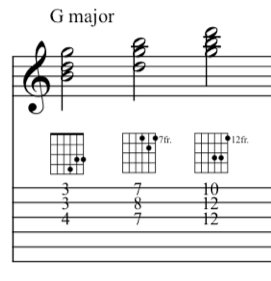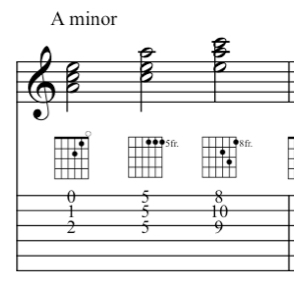Triad Substitution Pairs over The I Chord
Let me start by explaining what “triad substitution” means.
The title says, “Triad Substitution Pairs over The I Chord”
The I chord in the key of C, is a C chord.
When the whole band is jamming on a C chord groove, and you are playing other chords on top of that C chord, that kinda sound like C chords, but that aren’t C chords, then you are playing what is called “substitutions”
“Triad” means “3-note chord”.
So “triad substitution” means: you are jamming with 3-note chords over another chord.
How to Identify Substitutions: It’s All About Chord Tones
In order to figure out which chords you can play over a C chord, it helps to know what the notes in a C chord are.
A C chord consists of the notes C E G
When you make it a 7th (4-note) chord, you get Cmaj7, with notes C E G B
Which chords can you substitute a C chord with?
Answer: with other chords that have a lot of the same notes.
Those chords are:
Em –> E G B –> Em creates a Cmaj7 sound when played over a C chord or bass
Am –> A C E –> Am creates a C6 sound when played over a C chord or bass
G –> G B D –> the G major chord creates a Cmaj9 sound when played over a C chord or bass
Substitution Pairs
If you only use one of the above substitutions, you are only soloing with 3 notes: the 3 notes of that chord.
Things get really interesting though when you solo with a pair of 2 substitutions.
While you could combine any 2 chords (Em Am, Em G, G Am), I found that this gets especially fun when you solo with a pair of 2 chords a 2nd interval apart, which in this case is G and Am.
Here are the shapes on the top 2 strings for all G and Am triads.


Once you learned those 6 shapes, you can solo with them over a C chord.
4 Ways To Solo with Triad Substitution Pairs.
- Block chords
You hit all 3 notes in the chord shapes simultaneously.
You create melodies with the top note in each chord shape, by moving around a lot horizontally from shape to shape. - Vertical: Arpeggios
Here you don’t hit all 3 notes at once in every shape, but pick the notes in the chord shape separately as an arpeggio, and lift up your finger before you play the next note, so all notes are sounding one after another, like a guitar solo.
You switch back and forth between G and Am shapes.
- Horizontal: root to root, 3rd to 3d, 5th to 5th
This is probably my favorite on this list.
You can combine a horizontal and vertical approach. What this simply comes down to, is that you are playing 2nd intervals only, moving back and forth from the 3d of one chord to the 3rd of the next chord on the same string, then on the next string from the 5th of one chord to the 5th of another chord, then on the next string from the root of one chord to the root of the other chord.So for the G and Am chord, you would basically play the notes
B C (3rd of G chord followed by 3rd of Am chord)
D E (5th of G chord followed by 5th of Am chord)
G A (the root of G chord followed by the root of Am chord)You can of course also go descending
C B
E D
A Gor skip strings, or change string order, … all of which makes for some very interesting sounded phrases.
- Adding Chromaticism
This jazzes it up.
Here you add in the notes in between G and A, and in between D and EIn next week’s blog, we’ll cover fun substitutions over the G7 chord.
Conclusion
Hit me up anytime at vreny@zotzinmusic.com if you have any questions, or if you would like to book a lesson.
These free lessons are cool, but you will never experience the progress, joy, and results that my students experience in lessons when you’re learning by yourself from blogs and videos.
That is why people take lessons: way better results and progress, much more complete information, exposed to way more creative ideas than you can get from a blog or YouTube video.
There is only so much that self-study can accomplish.
If you want to see amazing results and progress in your guitar playing, buy your first lesson here and get started ASAP.
You’ll impress your friends and loved ones in no time with your guitar playing!
Consider donating any small amount to help me keep this blog going.
Thank you for your support!


